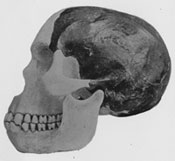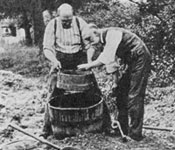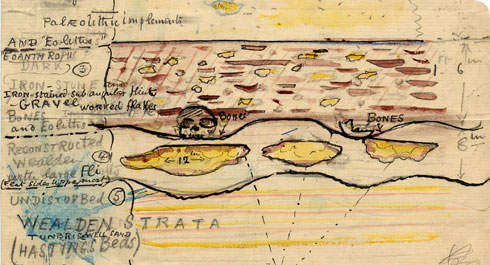Discoveries at Piltdown
When Piltdown Man was unveiled to the world in December 1912, news of the evolutionary 'missing link' caused a sensation. And so the infamous scientific fraud, one that would influence research into human origins for the next 40 years, took hold. Find out how the story began.
A matter of national pride
In 1912 the search for the 'missing link' between apes and humans was intense. Darwin's On the Origin of Species had been published only 53 years previously. In Europe, fossils of early humans had been found in Heidelberg and the Neander Valley in Germany and Cro-Magnon in France, but evidence from the British Isles was lacking.
Then, early in 1912, amateur archaeologist Charles Dawson wrote a letter to Arthur Smith Woodward, Keeper of Geology at the Natural History Museum. In it, he revealed he had found a piece of thick human-like skull in Pleistocene gravel beds at Piltdown in Sussex.
Dawson and Smith Woodward joined forces to pursue this exciting find over the summer, unearthing more skull fragments, a jawbone with 2 teeth, and a variety of animal fossils and primitive stone tools. These were taken as further evidence of Piltdown Man's ancient existence.

Reconstruction of Piltdown Man's skull by Arthur Smith Woodward.
Dawson's Dawn Man
Believing the skull fragments and jawbone to be from the same individual, Smith Woodward made a reconstruction. It suggested an early human with a large brain, indicating a level of intelligence that set it clearly apart from the apes. The jawbone, ape-like but with human-looking teeth, linked the skull with its supposed evolutionary ancestors.
They decided the evidence added up to an early human relative who lived about 500,000 years ago. Smith Woodward gave the new species the scientific name Eoanthropus dawsoni, Dawson's Dawn Man.
Silencing sceptics

Charles Dawson and Arthur Smith Woodward sieving excavated material at Piltdown in Sussex.
On December 1912, at a packed Geological Society meeting, Smith Woodward announced the discovery of Piltdown Man to the world. The scientific establishment was for the most part convinced. A single canine tooth found in 1913 provided further evidence.
This was followed in 1914 by an ancient-looking implement carved from a piece of fossil elephant bone. It looked remarkably like part of a cricket bat. The picture of the ancient Briton seemed complete.
Dawson claimed to find a molar tooth and skull pieces that closely matched those of Piltdown Man at a nearby site in 1915, which silenced some of the remaining dissent. But since Dawson's death from septicaemia in 1916, no other evidence has ever been discovered.
